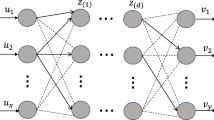Abstract
This paper investigates the increase in the response speed and stability of artificial intelligence systems that control dynamic technical objects. The problem of calculating the optimal time of switching an artificial intelligence system between software classes by the criterion of the rigidity degree of the model of a control object is considered. The solution of this problem is proposed for the general case of the control object dynamics when the rigidity of the mathematical model can significantly change during functioning and it is necessary to dynamically determine the moment of transition from standard methods of numerical integration to specialized numerical methods intended for calculating rigid dynamic models.
Similar content being viewed by others
References
M. A. Boden, AI: Its Nature and Future, Oxford University Press, Oxford (2016).
K. Rajan and A. Safiotti, “Towards a science of integrated AI and Robotics,” Artificial Intelligence, Vol. 247, 1–9 (2017).
G. Benysek, M. P. Kazmierkowski, J. Popczyk, and R. Strzelecki, “Power electronic systems as crucial part of a smart grid infrastructure — a survey,” Bulletin of the Polish Academy of Sciences (Technical Sciences), Vol. 59, No. 4, 455–473 (2011).
V. V. Khilenko, “Mathematical modeling of the effect of “splashing out” and optimization of management of banking and economic systems under globalization conditions,” Cybernetics and Systems Analysis, Vol. 54, No. 3, 376–384 (2018).
Computational Mathematics: Theory, Methods and Applications, P. G. Chareton (ed.), Nova Science Pub. Inc., NY (2011).
V. V. Khilenko, “Convergence of the order decrease method for solution of the rigid systems of linear differential equations,” Reports of the Academy of Sciences of the Ukrainian SSR, No. 8, pp. 76-79 (1987).
Yu. V. Rakitskii, S. M. Ustinov, and I. G. Chernorutskii, Numerical Methods for Solving Stiff Systems [in Russian], Nauka, Moscow (1979).
V. V. Khilenko, Methods of System Analysis in Solving Problems of Research of Adaptive Communication and Control Systems, Interlink, Kyiv (2003).
V. Hájovská, K. Kotuliaková, and I. Kotuliak, “HARQ schemes for HSDPA — analysis and simulation,” in: Proc. 50th Int. Symp. ELMAR-2008 (Zadar, Croatia, 10–12 Sept. 2008), Croatian Society Electronics in Marine, Vol. 2, 557–560 (2008).
Author information
Authors and Affiliations
Corresponding author
Additional information
Translated from Kibernetika i Sistemnyi Analiz, No. 6, November–December, 2018, pp. 18–26.
Rights and permissions
About this article
Cite this article
Khilenko, V.V., Strzelecki, R. & Kotuliak, I. Solving the Problem of Dynamic Adaptability of Artificial Intelligence Systems that Control Dynamic Technical Objects. Cybern Syst Anal 54, 867–873 (2018). https://doi.org/10.1007/s10559-018-0089-x
Received:
Published:
Issue Date:
DOI: https://doi.org/10.1007/s10559-018-0089-x




